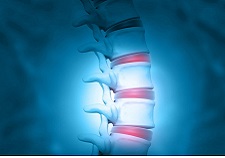Office of Research & Development |
 |


Pharmacist Dr. Corey Hayes and colleagues found that higher opioid doses did not bring more pain relief—but did increase the risk of harmful side effects. (Photo by Jeff Bowen)
February 3, 2020
By Tristan Horrom
VA Research Communications
"What we found...was that the pain relief the provider and the patient are going for really isn't there when they increase their doses."
Increasing chronic pain patients’ opioid prescription doses does not seem to improve pain, according to a VA study. Researchers from the Central Arkansas and Minneapolis VA health care systems and three universities looked at prescribing data of more than 50,000 VA patients taking opioids. They found that patients who had their opioid dosage increased did not have meaningful improvements in pain, compared with patients who continued to take the same dose.
The findings led the study authors to warn that “clinicians should exercise extreme caution when embarking on a path of increasing opioid doses to manage non-cancer pain.”
The results were published in the Jan. 9, 2020, issue of the journal Pain.

VA opens new research center to seek novel arthritis treatments

Injectable gel could help treat degenerative back pain

Virtual reality technology helps Veterans in pain

Study outlines guidance for treating cancer patients who show a problematic pattern of opioid use
A companion study by the same team that appeared online Jan. 15, 2020, in Addiction confirmed increased risk of side effects from higher doses.
“What we found … was that the pain relief the provider and the patient are going for really isn’t there when they increase their doses,” said lead author Dr. Corey Hayes in a University of Arkansas for Medical Sciences report . “You don’t see the benefit, but you do see the risk. Our overall message is, when you’re thinking about increasing the dose, you need to realize the risk it brings, too.”
Opioid medications relieve pain. They reduce the intensity of pain signals in the brain and affect areas of the brain controlling emotion, which diminishes the effects of pain stimuli. While opioids can help manage pain when taken correctly, they have a high risk for abuse and addiction.
Patients often receive increased doses of opioid medication because their pain may not be well-controlled on lower doses. People can also develop a tolerance to opioids over time, meaning a higher dose is needed to get the same effects. In these cases, prescribers must weigh the risks and rewards of escalating a patient’s opioid dose.
Higher opioid doses can lead to a variety of side effects, such as constipation, dizziness, increased sensitivity to pain, and increased risk of substance use disorder.
Despite common prescribing practices, the benefits of increasing opioid dose for chronic pain are not well understood. To get a better idea of whether escalating opioid prescriptions leads to better pain management, researchers looked at the medical records of VA patients prescribed opioids for chronic pain between 2008 and 2015. The patients were being treated for arthritis, back pain, neck pain, neuropathic pain, or headache/migraine.
During the study period, nearly 21,000 patients had their opioid dose escalated. Dose escalation was defined as a more than 20% increase in average daily dose. These patients were compared with more than 32,000 patients who continued to take the same opioid dose.
Patients rated their pain on the Numerical Rating Scale during routine clinical encounters. On the scale, 0 means no pain and 10 means the worst pain imaginable. This scale is one of the most common self-report pain measures.
Patients in the dose escalation group had consistently higher average pain scores than the maintainer group both before and after dose escalation, although the overall differences were small. However, the results show that their pain scores did not go down to any significant degree after their medication doses were increased. After 180 days after dose escalation, average pain scores only decreased by 0.1 on the pain scale. Changes in pain rating need to be at least 0.5 to 1.0 to be meaningful, according to the researchers. In fact, over the same period of time the average pain score for patients who kept the same dosage decreased by 0.3, a greater change than in the escalation group.
The results led the researchers to conclude that “increasing opioid doses was not associated with improvements in pain.”
The findings add to mounting evidence that opioid dose escalation does not lead to significantly improved pain scores. A 2016 study by researchers at the VA Portland Health Care System found that opioid prescriptions may actually be linked with a lower likelihood of improved pain scores. Another study by the same group, involving both Veterans and privately insured patients, found that higher opioid doses were associated with worse pain outcomes.
VA has taken steps to reduce opioid prescribing in response to the nationwide opioid epidemic. In 2013, VA launched the Opioid Safety Initiative. As a result, the number of Veterans prescribed opioids each year has decreased by 25% from the rate in 2013. As of 2016, only about 16% of VA patients received opioid prescriptions. The decline is mostly due to less long-term opioid prescribing, as opposed to short-term use for acute pain. Veterans are also receiving more non-opioid pain therapies, as well as more substance use disorder treatment.
To learn more about VA’s efforts to combat opioid dependence, visit the substance use disorder topic page on the VA Research website.
The new study was funded by the National Institutes of Health. In addition to VA, the authors represent the University of Arkansas for Medical Sciences, University of Minnesota Medical School, and University of Florida.
VA Research Currents archives || Sign up for VA Research updates